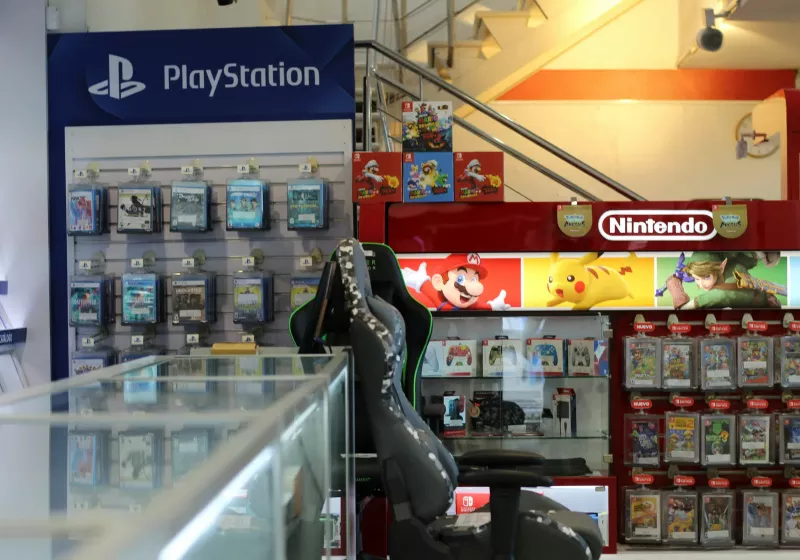As data storage needs grow from megabytes to terabytes, professionals in fields like video production recognize the importance of local storage alongside cloud solutions. However, local storage poses risks because hard drives can fail.
This is where Network-Attached Storage (NAS) systems come in. NAS utilizes RAID (Redundant Array of Independent Disks) technology to distribute data across multiple drives, protecting against drive failures and enhancing performance. With NAS, you can ensure your data remains secure and accessible, providing peace of mind in an increasingly data-driven world.
Also: The best M.2 SSDs of 2025: Expert tested and reviewed
What is the best NAS device right now?
Based on extensive testing, thorough research, comprehensive product review analysis, and expert opinions, my top pick for the best overall NAS device is the Synology Diskstation DS1522+. This exceptional NAS stands out as a powerful and robust option, equipped with top-tier hardware and excellent supporting software. It offers storage capacities of up to 60TB using robust and reliable server-grade drives.
You can't go wrong with this NAS, whether you need it for personal use, creative projects, or small business operations. Read on to discover all of my recommendations for the best NAS devices available on the market today. Each option has been carefully selected to meet various needs and preferences, ensuring you find the perfect storage solution for your requirements.
The best NAS devices of 2025
By far, the standout feature of any Synology NAS is the company's exceptional Diskstation Manager (DSM) software. While the Synology hardware is on par with many other NAS offerings, it's when that hardware is combined with the DSM software that Synology's offerings truly become noteworthy.
Also: We test the Synology DiskStation DS1817+ RAID
Synology's DS1522+ ships with built-in enterprise-grade data software and support for dozens of applications, OS, and SaaS services. Featuring five hard drive bays by default and expandable up to 15 bays total, the DS1522+ is an economical NAS solution with plenty of room to expand as the user's data storage needs grow.
Running Diskstation Manager, this NAS option comes with Synology's suite of enterprise backup solutions. This includes Active Backup for Business which allows users to backup Windows PCs, VMs, SaaS applications like Microsoft 365.
Also included is Synology's Hyper Backup software, which allows you to back up your entire NAS or specific files and folders to most major cloud service providers. This flexible and free backup software gives the user enterprise-grade tools in an easy-to-understand format. This makes setting up a proper 3-2-1 backup environment a breeze, no matter what or how many devices you're responsible for.
The DS1522+ is also a certified storage device for VMware and is compatible with most major virtualization platforms, including Windows Server, Microsoft's Hyper-V, and Citrix.
Synology Diskstation DS1522+ specs: Drive bays: 5 | Max capacity: 108TB | Max w/expansion units: 270TB | RAM: 8GB DDR4 (32GB max) | 1GB Ethernet ports: 4 | 10GB Upgrade: with Gen3 x2 upgrade | USB 3.2 ports: 2 | eSATA ports: 2 | M.2 slots: 2
Read More
Show Expert Take Show less
Also: How to set up your own NAS for more reliable data backups
Move over hard drives, solid state drives (SSDs) are the go-to choice for performance. While traditional spinning hard drives still excel in terms of price and capacity, solid state M.2 drives have proven themselves to be more than reliable.
SSDs offer significant advantages including faster read and write speeds, greater durability, and lower power consumption. As technology advances, the price gap between SSDs and hard drives has narrowed, making them more accessible than ever. For those seeking a balance of performance and reliability, solid state drives are undoubtedly the way to go.
The TerraMaster F8 SSD is the first 8-bay, all-SSD NAS designed specifically for small businesses. Built around an N95 4-core, 4-thread processor with a turbo frequency of up to 3.4GHz this 8-bay NAS is no bigger than a hardback book, and yet delivers read and write speeds up to 1,024MB/s.
Another advantage of using SSDs is that the unit doesn't have a pile of spinning disks, so even with active cooling it runs at a whisper quiet 19dB, even under full load.
TerraMaster F8 SSD Plus specs: Drive bays: 8 | M.2 SSD slots: 8 | Max capacity: 64TB | RAM: 8GB DDR5 | 10G Ethernet ports: 1 | USB 3.0 ports: Dual 3.2 | PCIe Gen 3 x8 slots: Support PCIe 3.0 | HDMI: HDMI 2.0b
Read More
Show Expert Take Show less
This Asustor Lockerstor model bridges worlds in a number of ways. First, by providing six hard drive bays as well as support for four M.2 sticks, it's possible to do some very interesting performance tiering work, both automatically and manually. Second, like the QNAP, the Lockerstor has HDMI output, possibly moving this from the server closet to the family room.
The internal 8GB RAM is respectable, and ZDNET was impressed with the 2.5G Ethernet port. The Lockerstor 6 uses the ADM operating system with more than 200 App Central applications, including various tools, business applications, office applications, and digital home entertainment.
A common theme in the reviews of this NAS is ease of use, which for what can be a complex network product, will be a breath of fresh air for those who are not tech experts.
Asustor Lockerstor 6 Gen 2 specs: Drive bays: 6 | M.2 SSD slots: 4 | Max capacity: 120TB + M.2 capacity | RAM: 8GB | 2.5G Ethernet ports: 2 | USB 3.0 ports: Dual 3.2Gen 2x1 | PCIe Gen 3 x4 slots: Support PCIe 3.0 on M.2 SSD | HDMI: HDMI 2.0b
Read More
Show Expert Take Show less
QNAP has a broad selection of NAS devices, and this lower-cost entry-level unit is absolutely worth consideration. At only $200 without drives, this option provides you with a way to quickly create a private home cloud.
Powered by an ARM Cortex-A55 2.0GHz processor, this NAS station can serve two valuable purposes at home -- working as a backup machine for Windows and Mac (via NetBak Replicator software and Time Machine), and as a storage system for your multimedia, including photos, videos, and important documents.
The entry-level NAS comes with 3.5-inch drive bays that are 2.5-inch compatible. Customer reviews suggest that this NAS is excellent value for money, with one reviewer saying it "punches above its class." However, others say the user interface needs improvement.
The Amazon reviews on this product are strong, with many users emphasizing the value this NAS device offers compared to other high-end units.
QNAP TS-233-US 2-Bay NAS specs: Drive bays: 2 | Max capacity: Diskless | RAM: 2GB (up to 4GB) | Ethernet ports: 1 | USB 2 ports: 2 | USB 3.2 ports: 1
Read More
Show Expert Take Show less
TerraMaster is a solid storage space at a budget-friendly price. We found the user interface to be clean and well done and the overall usage experience to be solid. To be clear, this is not a Synology, but that device is considerably more expensive.
TerraMaster is upping its game with the F4-423. Instead of a budget device, this is a performance machine, but at a mid-tier price. It's got two high-speed Ethernet ports, an HDMI port that lets you turn this into a media center server, and support for additional applications. TerraMaster says this model provides improved speeds and up to a 50% improvement in handling high-load workflows.
Overall, this is a solid product for higher-stress loads at a reasonable price. Cheaper, two-bay options are also available. Customers say this NAS solution is great for home setups, although some are irritated by its lack of documentation.
Reviews for the TerraMaster F4-423 on Amazon and Reddit take note of the stylish exterior of this NAS cabinet, as well as the performance and value for money it offers.
TerraMaster F4-423 specs: Drive bays: 4 | Max capacity: 80TB | RAM: 4GB | 2.5G Ethernet ports: 2 | USB 3.2 ports: 2 | HDMI port: 1 | M.2 slots: 2
Read More
Show Expert Take Show less
Ugreen is a new kid on the block in terms of NAS systems, but don't let that fool you -- the NAS products they have are of the same quality that I have come to expect from the company's other products.
This two-bay unit features an Intel N100 Quad-core CPU, 8GB DDR5 RAM, 2.5GbE, and an 4K HDMI port. There are even two M.2 slots, and with all bays and slots filled up the NAS can hold up to 64TB of storage.
This NAS has it all, including advanced encryption and advanced user account setup, so your data is fully protected.
Ugreen NASync DXP2800 specs: HDD/SSD | Max capacity: 64TB | RAID: JBOD/Basic/0/1 support | M.2 Slots: 2 | USB ports: 1x USB-C and 3x USB-A | HDMI port: 1 | Ethernet: 2.5GbE
Read More
Show Expert Take Show less
What are the tariffs in the U.S.?
The recent U.S. tariffs on imports from countries like China, Vietnam, and India aim to boost domestic manufacturing but are likely to drive up prices on consumer electronics. Products like smartphones, laptops, and TVs may become more expensive as companies rethink global supply chains and weigh the cost of shifting production.
Also: Tariff war has tech buyers wondering what's next. Here's what we know
Storage device such as external hard drives and NAS units have also hit hard by the new U.S. tariffs, with import duties potentially increasing prices by up to 35%. Many major brands still rely on Chinese and Vietnamese factories for assembly, meaning consumers could soon pay significantly more for everything from budget Chromebooks to high-end gaming rigs.
Manufacturers are exploring options like relocating production to countries with lower tariffs, but such shifts are complex and may not provide immediate relief. In the short term, shoppers should anticipate higher costs for accessories due to these trade policies.
Right now, it looks like some tech may be exempt from the issued tariffs, but since it's always changing and developing, we are keeping an eye on it and will update you on the latest.
Also: Tariff exemptions for electronics offer a break for tech - but not for long
ZDNET ranks the Synology DiskStation DS1522+ as the best NAS device currently on the market. This model stands out as a powerful and durable choice, supported by an excellent suite of applications. If the DS1522+ doesn't meet your specific needs, here are the top features to look for in alternative models:
Best network attached storage | Price | Bays | Storage as sold | Ethernet |
Synology Diskstation DS1522+ | $1,850 to $2,700 | 5 | 20TB to 50TB | 4x 1GbE ports |
TerraMaster F8 SSD | $600 | 8 | Diskless | 4x 1GbE ports |
Asustor Lockerstor 6 Gen 2 | $809 | 6 | Diskless | 2x 2.5GbE ports |
QNAP TS-233-US 2-Bay NAS | $199 | 2 | Diskless | 1x GbE port |
TerraMaster F4-423 | $453 | 4 | Diskless | 2x 2.5GbE ports |
Ugreen NASync DXP2800 2-Bay NAS | $315 | 4 | Diskless | 1x 2.5GbE port |
Choosing the right NAS device is a straightforward process, beginning with an assessment of your budget and storage requirements. Vendors typically offer models starting from two bays -- allowing for two drives -- and upwards.
For those requiring substantial storage, opting for a model with more bays is advisable. However, if you're venturing into NAS devices for the first time, you might want to start with an entry-level or portable option. This allows you to become acquainted with NAS technology without committing to more advanced and costlier equipment immediately.
Below is a simple chart to assist you further in making your decision:
Choose this NAS device... | If you want... |
Synology Diskstation DS1522+ | The best overall NAS. By combining solid hardware and a best-in-class DSM software, this unit promises comprehensive storage for small businesses and remote workers alike. |
TerraMaster F8 SSD | Forget HDD and embrace the performance of the SSD. Not only does this NAS offer incredible performance, but the use of SSDs means that an 8-bay device is no bigger than a hardback book. |
Asustor Lockerstor 6 Gen 2 | The best NAS from a reputable brand. This model also features six hard drive bays, support for four M.2 sticks, and uses the ADM 4.0 operating system. |
QNAP TS-233-US 2-Bay NAS | The best value storage with solid performance. This entry-level model will add considerable value to your network without breaking the bank. |
TerraMaster F4-423 | The best mid-tier NAS with a nice user interface. Coming at a mid-tier price, it still has two high-speed Ethernet ports, an HDMI port, and accounts for higher stress loads. |
UGREEN NASync DXP2800 2-Bay NAS | The perfect NAS for your desktop. Compact, but powerful, with the capacity to put a whopping 64TB of storage on your desk! |
When in the market for a new NAS device, it's crucial to consider several key factors to ensure you choose the option that best suits your needs:
Use Cases: Identify the primary function of your NAS device. Whether it's for video editing, setting up a home office, or entertainment purposes, understanding its intended use is vital given the investment. This clarity will guide your decision-making process.
Budget: Determine your budget early on. NAS systems are significant investments, often carrying a hefty price tag. Additionally, if you opt for a diskless model, remember to account for the cost of purchasing storage separately.
Bays: The number of bays you need is directly tied to your storage requirements. For those handling extensive multimedia files or planning long-term storage, opting for a device with more bays is advisable.
Connectivity: NAS devices vary in their connectivity options, from Ethernet and HDMI ports to portable models that can generate Wi-Fi hotspots. Ensure the device you choose has the connectivity features that align with your needs.
Here at ZDNET, our expertise in NAS devices spans decades. Our selections are informed by a combination of in-depth testing, verified customer feedback, and real-world user interactions, with particular emphasis on user-friendly interfaces, performance, a thorough assessment of each model's strengths and weaknesses, and, importantly, price point.
User-friendly Interface: We prioritize NAS models that are straightforward to set up and manage, featuring software that simplifies usage and enhances sharing and collaboration capabilities.
Fast Performance: A NAS device accelerates saving and retrieving the data, making it particularly efficient for tasks like video editing -- outpacing many cloud storage services.
Strengths and Weaknesses: Understanding that no model is flawless, we highlight the advantages and drawbacks of each, providing clarity on how they might match your security needs, setup preferences, and workflow requirements, including portability.
Price: Recognizing budget constraints, we carefully consider each product's price. Although initial costs can be high, they may offer savings over time compared to ongoing cloud service subscriptions.
You can repurpose an old PC or even build a very custom NAS solution to meet your exact needs.
ZDNET author and resident hardware expert David Gewirtz has built his own NAS boxes for years, including some that were highly customized. But as the NAS offerings from vendors like Synology, QNAP, and Drobo improved, the need to build his own diminished.
If you're comfortable with the prospect of sourcing PC parts and building PCs, you'll probably want to go it on your own. But if you're new to PC building, buying an appliance NAS is probably the way to go.
RAID, which stands for Redundant Array of Independent Disks, is a data storage technology that combines multiple physical disk drives into a single logical unit for improved performance, redundancy, or both. The primary purpose of RAID is to enhance data protection and improve storage efficiency by distributing data across several disks in various configurations known as RAID levels.
Here's a breakdown of three of the most common RAID levels:
RAID 0 (Striping)
RAID 0 splits, or stripes, data evenly across two or more disks. This configuration offers improved performance because multiple disks can be read or written simultaneously. However, be aware that this provides no redundancy. If one disk fails, all data in the array is lost.
RAID 1 (Mirroring)
RAID 1 duplicates, or mirrors, data across two or more disks. This setup offers high data redundancy because each disk in the array contains an exact copy of the data. If one disk fails, the data can be recovered from the other disk(s). However, note that RAID 1 does not improve performance and effectively reduces usable storage capacity by half.
RAID 5 (Striping with Parity)
RAID 5 combines striping with parity, distributing data and parity information across three or more disks. Parity provides fault tolerance, allowing the array to withstand the failure of a single disk without data loss. RAID 5 offers a good balance of performance, redundancy, and storage efficiency.
The primary difference between Network Attached Storage (NAS) and Direct Attached Storage (DAS) lies in how they are connected to and accessed by devices in a network.
NAS devices connect to a network, typically through Ethernet, providing storage that can be accessed by multiple devices on that network. This setup allows multiple users and devices to access and share data simultaneously over the network, making NAS ideal for collaborative environments. NAS units often come with their own operating systems and can support a variety of applications, including file sharing, media streaming, and even server functions like web hosting. These devices are managed via a web-based interface, allowing for remote administration and configuration. Additionally, NAS solutions are generally more scalable, allowing for easy expansion by adding more drives or connecting additional NAS units to the network.
In contrast, DAS devices connect directly to a computer via USB, Thunderbolt, or another direct interface, making them accessible only to that specific computer. DAS systems are typically single-user devices, meaning only the connected computer can access the stored data. For other devices to access this data, it must be shared through the computer to which the DAS is connected. DAS units are simpler and usually do not come with their own operating systems or support for additional applications beyond basic storage. These devices are managed directly through the operating system of the connected computer, without the need for web-based interfaces. Because they connect directly to a computer, DAS devices can offer faster data transfer rates compared to NAS, which relies on network speeds.
The choice between NAS and DAS depends on specific requirements for accessibility, scalability, and performance. NAS is best suited for environments where multiple devices need to access and share data, such as in homes with multiple users, small businesses, or professional settings requiring collaborative access to large files. On the other hand, DAS is ideal for single-user scenarios where fast data transfer rates are critical, such as video editing, graphic design, or personal data storage needs.
Vendors typically estimate the lifespan of a NAS device to be between three to five years. However, it's possible for a NAS to exceed this range, potentially lasting up to a decade. Despite this, the risk of failure escalates over time.
Be on the lookout for signs of hardware deterioration, like sluggish performance and connectivity problems, which may indicate impending failure.
You can potentially improve a NAS device's lifespan by allowing it to hibernate while not in use. For example, if you are away from home for several months, you may want to consider giving it a rest. However, NAS devices can be left on permanently, as many NAS devices have been specifically built to allow this.

 3 months ago
6
3 months ago
6









 English (US) ·
English (US) ·